

10 1108 QRJ 06 2020 0054. Snapshots of selfhood: curating academic identity through visual autoethnography: International Journal for Academic Development: Vol 25, No 4. View of Digital Auto-Ethnography. Full article: Re-learning from experience: using autoethnography for teacher development. New Methods of Literacy Research. A Collaged Reflection on My Art Teaching: A Visual Autoethnograph.
Full article: Snapshots of selfhood: curating academic identity through visual autoethnography. Snapshots of selfhood: curating academic identity through visual autoethnography: International Journal for Academic Development: Vol 25, No 4. Tech and me: an autoethnographic account of digital literacy as an identity performance. Adams, T.
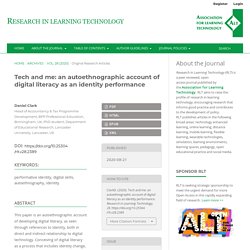
E., Jones, S. H. & Ellis, C. (2015) Autoethnography, Oxford University Press, NewYork, NY. Bali, M., et al., (2015) ‘What makes a cMOOC Community Endure? Tech and me: an autoethnographic account of digital literacy as an identity performance. Microsoft Word - Autoethnographic journalism subjectivity and emotion in audio storytelling Jan 2017 DRAFT.docx. Autoethnography. Autoethnography - an overview. Emotional Methods If we accept that researchers are themselves inevitably involved in the emotional work of research, then certain commonly used methods such as interviewing, focus groups, and textual analysis need to evolve and incorporate an exploration of the co-construction of emotions through people, space, and time.
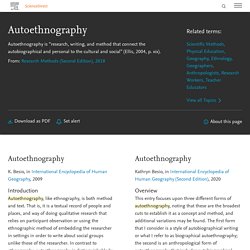
Autoethnography has perhaps become one of the most useful ways for researchers to analyze themselves alongside participants. Autoethnography is often linked to feminist research approaches that value making oneself vulnerable in the research experience and embracing emotion. The method is a rejection of the notion that the researcher is a bounded and unemotional entity, and therefore necessitates an almost constant reflexivity. Researchers are advised to explore their own emotional connections to topics and participants during fieldwork, analysis, and writing. View of Methodological and Analytical Dilemmas in Autoethnographic Research.
Maternal and child health chapter2. It’s all about ‘me’, with you: Exploring auto-ethnographic methodology. Neil Drabble, Course Leader, BA (Hons) Fashion Photography, London College of Fashion Abstract This article presents an excerpt from a longer MA Academic Practice dissertation which recorded face-to-face conversations with academic peers.
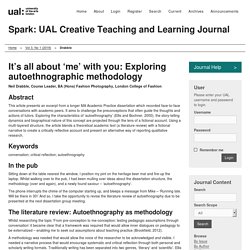
It aims to challenge the preconceptions that often guide the thoughts and actions of tutors. Exploring the characteristics of ‘autoethnography’ (Ellis and Bochner, 2000), the story-telling dynamics and biographical nature of this concept are projected through the lens of a fictional account. Using a multi-layered structure, the article blends a theoretical academic text (a literature review) with a fictional narrative to create a critically reflective account and present an alternative way of reporting qualitative research.
Keywords conversation; critical reflection; autoethnography In the pub Sitting down at the table nearest the window, I position my pint on the heritage beer mat and fire-up the laptop. Back in the pub. Autoethnography and podcasting. Full article: Reflecting on reflexive thematic analysis. Mapping the possibilities of qualitative research in music education: a primer: Music Education Research: Vol 8, No 2. 1.
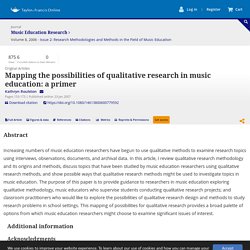
I recognize that any ‘quick guide’ to qualitative research risks oversimplification. My intent is to provide some points of reference to those who would like to further explore qualitative approaches to research in music education. 2. Proposals for the effective preparation of researchers in education have recently been discussed in Eisenhart and deHaan (2005 Eisenhart, M. and DeHaan, R. L. 2005. 3. 4. 5. 6. Charmaz 2006. 2017.01.04 Daniel and David January 4 Wednesday 2017 Final submitted (1) Easier Said than Done: Writing an Autoethnography. s3. We thank the following reviewers who rendered extraordinary service to Qualitative Inquiry, Volume 7. A collaborative autoethnographic search for authenticity amdist in "the fake real" When Teacher Becomes Student: Unveiling Contradictions within Australian Social Work Education. 1.

Introduction This article examines my unique and individual experience of being a simultaneous social work student and academic. This occurred due to my desire to contribute to social justice but also due to rules set down by the accrediting body, the Australian Association of Social Workers (AASW). International Journal for Academic Development. Listening as a path to psychological discovery: an introduction to the Listening Guide. Critical Qualitative Inquiry - Norman K. Denzin, 2017.
Toward a Moderate Autoethnography - Sarah Stahlke Wall, 2016. Methodological Background of Autoethnography Qualitative research in the social sciences has often involved a personal connection between the researcher and the field being studied (Anderson, 2006).
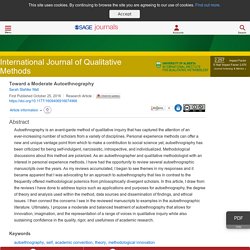
Most often, however, although researchers may have studied settings in which they were closely involved in their personal lives, there has been a general tendency to limit any significant emphasis on the researcher himself or herself as a part of the study (Anderson, 2006). There have been some exceptions such as A Chinese village by Yang (1945), which is an autoethnography written entirely from the author’s memories of his childhood, and Wallace’s detailed descriptions of his everyday activities in Driving to work (1965) and A day at the office (1972). Yet, even by 1979 when David Hayano first coined the term “autoethnography,” his purpose in using this term was to describe traditional ethnography among one’s own people.
He explicitly stated, Insights From My Reviews Ethical Concerns. EJ1135865. Toward identity‐oriented teacher education: Critical autoethnographic narrative - Yazan - 2019 - TESOL Journal. TESOL scholars have underscored the crucial role of teacher identity not only in teacher learning and growth, but also in shaping classroom practices (Kanno & Stuart, 2011; Reeves, 2018; Varghese, Morgan, Johnston, & Johnson, 2005).
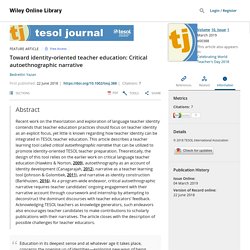
Teacher identity influences the ways in which teachers “construct their own ideas of ‘how to be,’ ‘how to act,’ and ‘how to understand’ their work and their place in society” (Sachs, 2005, p. 15). It provides “the basis” for teachers’ instructional “meaning making and decision making” (Bullough, 1997, p. 21). Literacy or language learner autobiographies have been established as a useful component in TESOL teacher education courses. Sociocultural conceptualization of TESOL teacher learning positions teachers as primary agents of teaching and teacher learning, rather than blank canvasses to be painted on with theoretical and practical knowledge (Freeman & Johnson, 1998).
Trahar EERJ 12 3 web 1. Austin Hickey Autoethnography 2007 PV. Canagarajah 2012 tq. (99+) (PDF) A Rhizomatic Edge-ucation: 'Searching for the Ideal School' through School Tourism and Performative Autoethnographic-We. (99+) (PDF) Practicing Narrative Inquiry. (99+) (PDF) On first-person narrative scholarship: Autoethnography as acts of meaning. (99+) (PDF) Using arts-based research exercises to foster understanding of reflexivity in qualitative research.
(99+) (PDF) Analyzing Flying Chameleons: Using Autoethnography to Explore Change in the Female Educator. Narrative Re Righting Recovering and Rebuilding a Life Rocked by Trauma. Journal of Contemporary Ethnography.